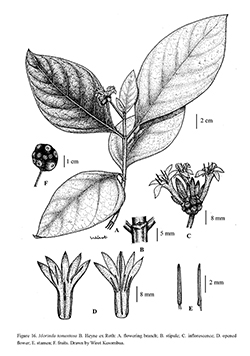e-Flora of Thailand
Volume 15 > Part 1 > Year 2021 > Page 101 > Rubiaceae > Morinda
9. Morinda tomentosa B.Heyne ex Rothwfo-0000246112
Nov. Pl. Sp.: 147. 1821; Kurz, Forest Fl. Burma 2: 60. 1877; Craib, Fl. Siam. 2: 178. 1934; Kesonbua & Chantar., ScienceAsia 39: 338. 2013; Chantar., Thai Forest Bull., Bot. 47: 185. 2019.— M. tinctoria var. tomentosa (B.Heyne ex Roth) Hook.f., Fl. Brit. India 3: 156. 1880; Pit. in Lecomte, Fl. Indo-Chine 3: 425. 1924. Fig. 16.
Accepted Name : This is currently accepted.
Synonyms & Citations :
Description : Trees up to 15 m tall; young branches terete, bark smooth, greenish, densely puberulous; older branches subterete, bark shallowly fissured, brownish to grey, with sparse and short hairs. Stipules triangular, acute to acuminate, connate at base, usually caducous. Leaves elliptic, 15.5−23 by 8−9.5 cm, base cuneate, margin entire, apex acute or acuminate, coriaceous, dark or light green above, puberulous, greenish beneath, tomentose, lateral veins 8−12 pairs, venation conspicuous, domatia usually present in axils of lateral veins beneath, drying dark black; petiole 1−3 cm long, with dense hairs. Inflorescences solitary or paired capitula; peduncle at anthesis 2−4.5 cm long. Flowers 5−6-merous, fragrant, bisexual; heterostylous. Calyx tube basally connate, puberulous, lobes truncate or denticulate. Corolla salver-shaped, white or greenish; tube 1.5−1.8 cm long, inside glabrous, outside puberulous, lobes oblong, 3−5.5 by 10−14.5 mm. Stamens included or exserted in corolla tube, attached to tube by short filament; filaments linear, straight, 1−4 mm long; anthers yellow, oblong,5.5−6.5 mm long. Ovary 2-locular; style white, glabrous, 1.2−1.5 cm long in brevistylous flower, 1.5−1.8 cm long in longistylous flower; stigma bilobed, included or exserted in the corolla tube. Infructescences globose or subglobose, with 15−25 fruitlets; fruitlet with short and dense hairs, ripening black. Seeds ellipsoid or ovoid, 4.5−6.5 by 7−11.5 mm.
Thailand : NORTHERN: Mae Hong Son (Sop Moei), Chiang Mai (Doi Inthanon, Doi Muang Aon, Doi Suthep-Pui NP, Mae Klang Falls), Nan, Lamphun (Mae Tha), Lampang (Khun Tan NP), Phrae (Song), Tak (Ban Tak); NORTH-EASTERN: Loei (Phu Kradueng), Khon Kaen; EASTERN: Chaiyaphum (Pak Pang – lectotype of Morinda pumila: Kerr 19981 -BK, isolectotypes -ABD BM K KYO, designated by Chantaranothai 2019), Nakhon Ratchasima (Pak Thong Chai, Wang Nam Khiao, Sakaerat), Si Sa Ket (Kanthararak); SOUTH-WESTERN: Kanchanaburi (Erawan NP); SOUTH-EASTERN: Chon Buri (Khao Khiao).
Distribution : India (type), Myanmar, Indochina.
Ecology : In dry evergreen and deciduous dipterocarp forests, 100−720 m alt. Flowering: February−May.
Vernacular : Yo pa (ยอป่า), hatsa koei (หัสเกย), kho khamin (เคาะขมิ้น), sa kae (สะเกย), sa koei (สะกึย)(Northern); ta kroei (ตะเกรย)(Ratchaburi); talum phuk (ตะลุมพุก)(Khon Kaen); khu-yu (คูยู่), khwo (เควาะ)(Karen-Kanchanaburi).

